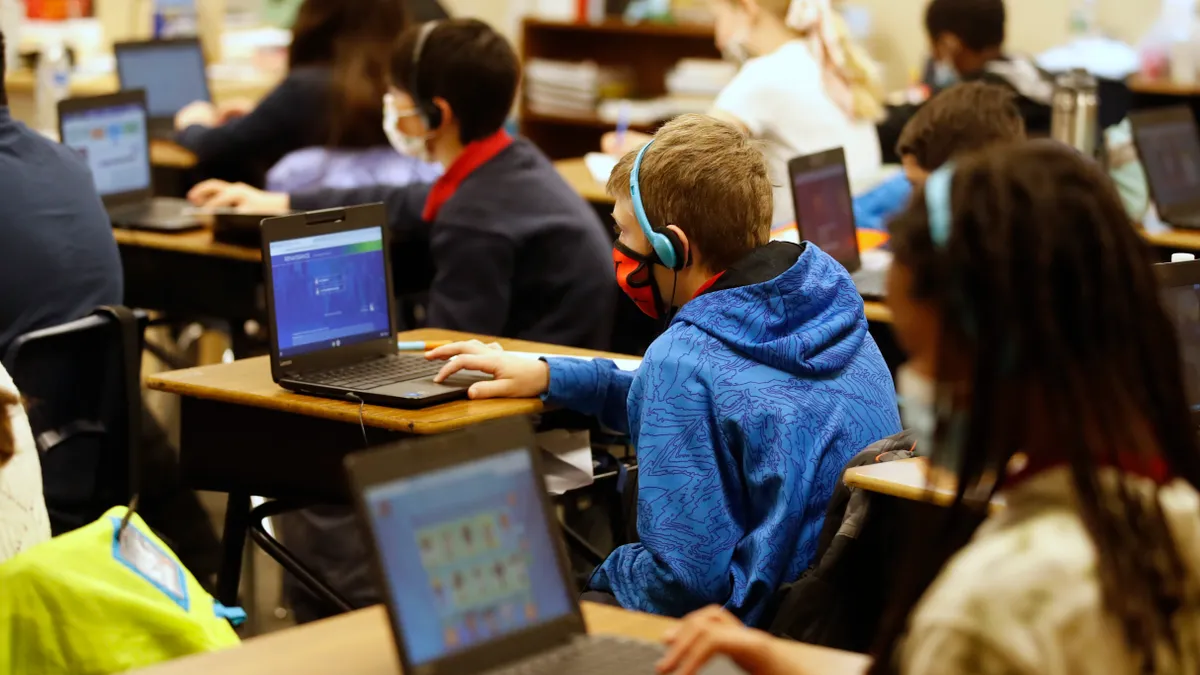Dive Brief:
- School systems’ monitoring practices for student online activity may be leading to disproportionate disciplinary practices or intruding on students' privacy, according to a new report from the Center for Democracy & Technology.
- Students in lower-income school districts, for instance, are subjected to more monitoring because they are more likely to be using a school-issued device rather than a personal device. In a poll of teachers, CDT found 71% said their school uses monitoring software on school-issued devices, and 16% reported surveillance of students’ personal devices.
- Although many school systems explicitly tell parents and students that there should be no privacy expectations when they use school-issued devices, administrators report they are conflicted about how to communicate what information the school collects about students’ digital activity.
Dive Insight:
The pandemic spurred school districts to hustle to distribute school-issued devices to students for remote learning. Even with in-person learning taking place this school year, many districts plan to retain 1:1 programs in an effort to close the homework gap.
According to the Consortium for School Networking's 2021 EdTech Leadership Survey Report, 49% of districts are supporting more than 7,500 devices, up from 2020 when 33% of districts managed that many devices.
Ed tech leaders say providing students school-issued devices can improve equitable access to learning. School leaders also are collecting and analyzing metrics for educator and student ed tech engagement to better understand how to make digital use more inclusive. LearnPlatform’s publicly-accessible National Ed Tech Equity Dashboard tracks students' digital use of ed tech sites across different student demographic groups.
But with more devices and online activity, districts’ responsibilities grew exponentially for monitoring students’ digital use as a way to protect them from bullying, self-harm, violence from others and inappropriate content. With that greater responsibility, school systems should be thoughtful in protecting students’ rights to privacy, said Elizabeth Laird, CDT’s director of Equity in Civic Technology Project.
For example, software that helps schools conduct digital surveillance may misinterpret a student’s online behavior, flagging it as a concern or a potential discipline issue when it is not, she said.
There are also concerns that software allowing districts to see what applications and websites students have open, as well as to view browsing histories, can limit students’ self-expression. The CDT survey found 58% of students who report their school uses monitoring software agree with the statement, “I do not share my true thoughts or ideas because I know what I do online is being monitored.”
Monitoring student’s online activity, however, may outweigh the privacy risks by attempting to protect students’ physical and mental health. Overall, 78% of teachers and 75% of parents responding to the CDT survey said they strongly or somewhat agree that the surveillance keeps students safe by identifying problematic online behavior, such as visiting websites about mass shootings, searching for instructions on how to harm themselves, or identifying activity that suggests substance abuse.
To help school systems better balance student privacy practices, CDT, along with at least five other organizations, have sent a letter to the Senate Committee on Commerce, Science, and Transportation and the House Committee on Energy and Commerce, asking that the Children’s Internet Protection Act be updated to clarify that CIPA does not require broad, invasive and constant surveillance of students’ online activity.
Staying compliant with CIPA is one of the main drivers for school district surveillance programs, the letter states. The groups want Congress to clarify that “monitoring” is narrow and limited to the minimal amount of data collection needed to achieve CIPA’s goals.
CIPA was enacted in 2000 and last updated in 2011 — a time when students’ educational online activity only took place in campus computer labs with teacher observation for a few hours a week, Laird said.
“Flash forward to now, the way that that's been interpreted is, is this kind of pervasive, always-on monitoring,” she said.
School monitoring practices shouldn’t just be done for legal compliance, Laird said. “They should be able to explain why they're doing it, connect it to some larger goal and not have this kind of unintentional expansion and constant monitoring of students.”












